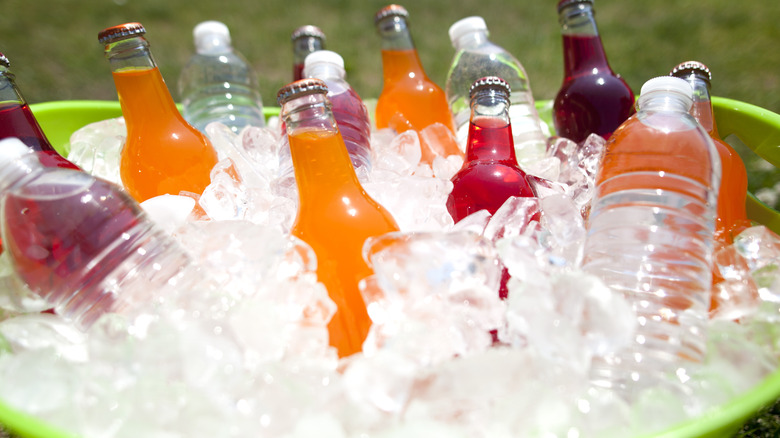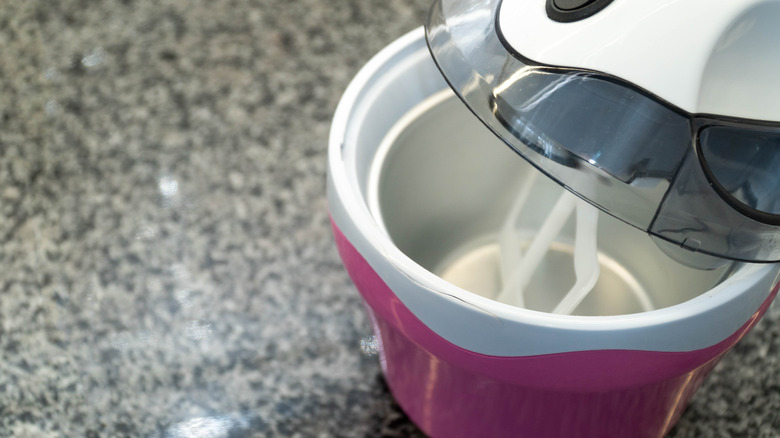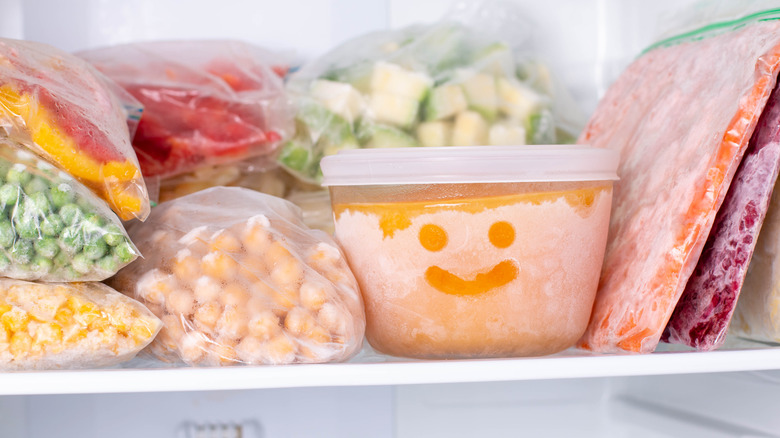The Salt Water Hack For Keeping Drinks Ice Cold On The Go
When the temperature is scorching, a cool, refreshing beverage can be the best way to cool you off. While some beverage containers might boast about keeping your drink cool for hours, that scenario is not always the case. When you've got loads of drinks to cool and the deep chill is needed quickly, this saltwater hack can be your cold beverage saver.
According to The U.S. Sun, quickly chilling a beer can be accelerated by submerging it in an ice, salt, and water bath. Although putting a bottle in a chilly solution seems straightforward, the added salt component is what lowers the overall temperature. This is because saltwater has a lower freezing point than regular water.
Even if happy hour is not customarily combined with science class, it helps to know that while freshwater freezes at 32 degrees Fahrenheit, saltwater freezes at 28.4 degrees. A colder environment will help to chill the items around it. By plunging those bottles into that salty ice bath, the lower temperature helps to turn your beverages colder more quickly than if they were simply submerged in a bucket full of ice alone.
Next time someone asks what to bring to the party, ask for ice and salt. The combination in the cooler might keep all those beverages perfectly chilled throughout the event.
Salt is the solution to bring the big chill
While party hosts might have discovered the saltwater hack for cooling beer and wine bottles more quickly (this easy hack can drop the temperature of a bottle of beer by a whopping 66 degrees Fahrenheit in just 30 minutes), this briny solution can also work in other scenarios. For example, freezing ice cream can be made more efficient with salted ice. As seen with an old-school ice cream churn, the custard container is surrounded by an icy slush. With each crank's turn, the creamy ingredients go from liquid to that soft solid we all love. Some people might think that it could take hours to transform from liquid to solid state, but it is not as time-consuming as you might think.
Even just using rock salt and ice works in a most simplistic method. Using a saltwater "slush" around your ice cream base will keep it cool enough for a long enough period of time to eventually thicken into ice cream. Simply using ice water here wouldn't be effective because it would melt before the ice cream has a chance to solidify. Another easy method includes placing one sealed bag inside another sealed bag of rock salt and ice to help freeze the inner bag of ice cream ingredients. Many people use this method to make a shaken ice cream. The resulting frozen treat might not be quite as creamy and rich as a traditionally churned option, but still, it can be fun and tasty to use science to make food.
Although flavor is king in the food world, a little scientific knowledge could help keep the big chill going a little longer. It might not be quite as precise as baking measurements, but appreciating that ice and salt create a lower temperature could save the dreaded warm drink, melted ice cream, and various other items.
Can a salted ice bath help maintain better quality in frozen food?
Given that salted ice water can more efficiently cool a beverage, can the concept be applied to freezing other foods? America's Test Kitchen discussed how a salty ice bath could create better-quality frozen food. In regards to frozen meats, the publication explained that quicker freezing will create smaller ice crystals. That chemical component helps to create less cellular damage, which will result in a juicier product when eventually thawed.
This hack doesn't just apply to meats, either. The salty ice bath method can be used with a variety of foods. From ground meat to liquid, the concept can be applied in many ways. Basically, if food is frozen more quickly, there will be less damage to the cellular wall. In simple terms, to avoid that mealy, less palatable texture, plunge food into the deep freeze salt water bath quickly and efficiently and then transfer your items into the freezer.
The idea of freezing food is not new, but companies and cooks are always looking for ways to improve the process. Charles Birdseye, the inventor of the quick freezing method, appreciated that speedily freezing food improved its taste and texture when eaten at a later date. If the idea is to preserve food at its best quality, a little scientific knowledge can help produce that preferred outcome. Avoiding food waste is always a reason to raise that cold beverage from the icy salt bath in a rousing toast.


